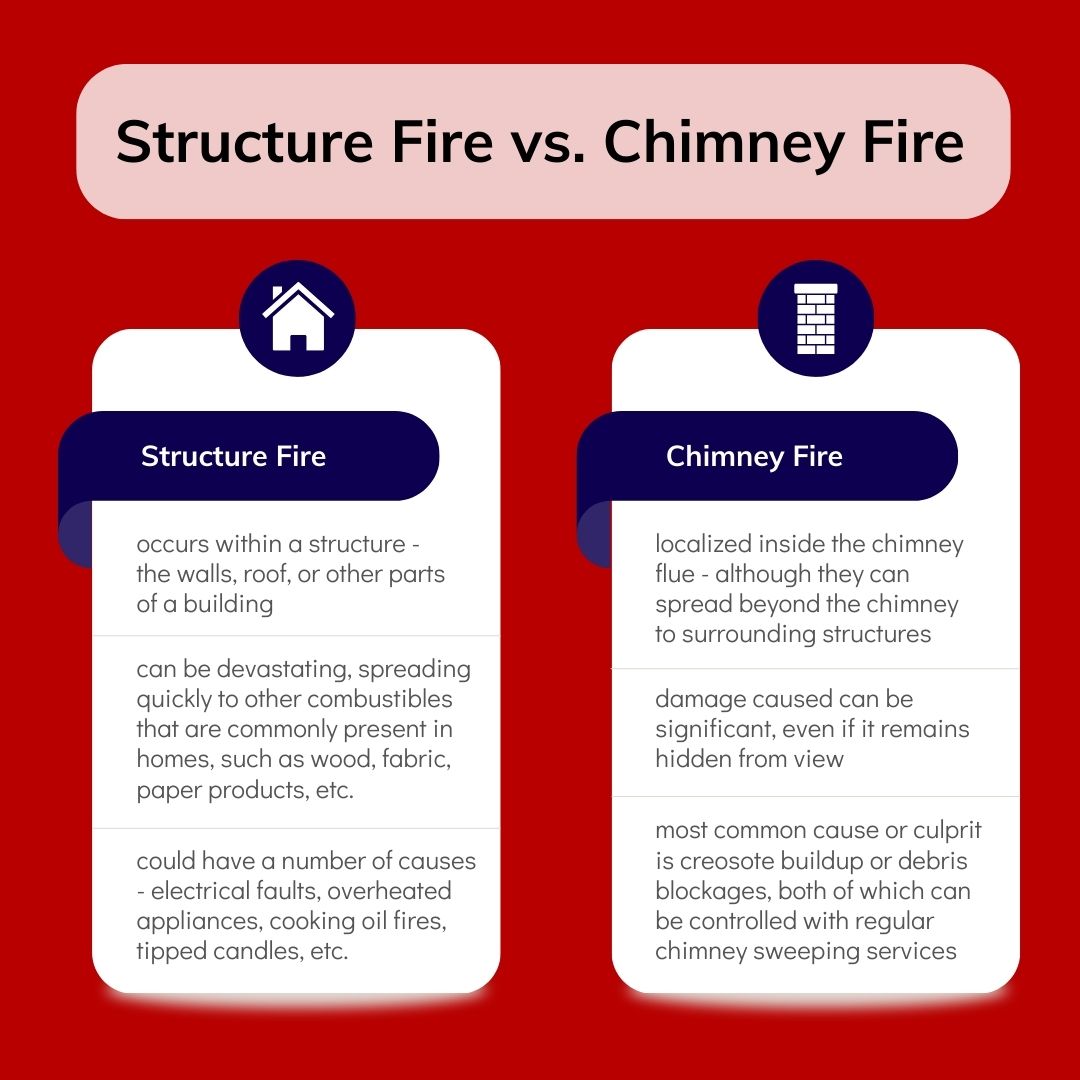The only fire you want in your house is one safely contained in your fireplace, a candle, or something similar. So why bother differentiating between types of fire?
At Lord’s Chimney, we believe knowledge is power when it comes to fire safety. Understanding a bit about different fires and how to prevent them can help you protect your home and family. For homes with fireplaces, chimney fires are a relevant category to learn how to prevent and what to do should one occur.
Structure Fires vs. Chimney Fires

Most of the time when we hear about a house fire, a structure fire is what comes to our minds. A structure fire is a fire that occurs within a structure – the walls, roof, or other parts of a building. Fires like these can be devastating, spreading quickly to consume combustables that are commonly present in homes, such as wood, fabric, or paper products.
Structure fires can have a number of causes ranging from electrical faults to overheated appliances, cooking oil fires to a candle out of control. It’s important to exercise preventive fire safety in the home, and also to know how to respond to different types of fires should one occur.
Chimney fires are localized inside the chimney flue, although they can spread beyond the chimney into surrounding structures. Localized doesn’t necessarily mean little damage though – the damage caused can be significant even if it remains hidden from view…and especially if left unaddressed.
The most common culprit in a chimney fire is creosote. Creosote is a dark, tarry substance that accumulates as a byproduct of combustion on the walls of a chimney flue. If creosote builds up, it only takes a spark or excessive heat to ignite it, so frequent chimney sweeping is key to preventing chimney fires. This service also allows us to remove other fire hazards, such as nests, twigs, leaves, and other debris.
Fires & Your Home: Insurance Matters
When it comes to insurance, the type, nature, and cause of a fire can impact how a fire-related claim is handled. Keep in mind that policies vary, so be sure to get familiar with the details of your particular insurance provider and policy.
Homeowners insurance policies usually cover structure fires, since these are considered sudden and accidental occurrences. Unexpected events can’t have been reasonably foreseen or prevented. However, it’s possible that insurers would investigate the cause of the fire to examine whether negligence was involved.
Chimney fires… Well, they can be a bit more complicated from an insurance perspective. Chimney fires are often linked to lapses in maintenance, and therefore might be more closely scrutinized. Some policies require proof that regular inspections and maintenance were carried out. If it’s determined that poor maintenance contributed to the fire, an insurance claim may be denied or reduced.
There are a lot of reasons to be diligent about chimney inspections, sweeping, and maintenance. Chimney fire prevention is one, but should a chimney fire occur, proper chimney care will also help ensure that you’re protected and able to make repairs without the additional burden of financial strain.
Preventing Fires: Proactive Measures for a Safer Home
Preventing structure fires may require a number of steps:
- Make sure your home appliances are operated and maintained according to manufacturer instructions.
- Inspections may be necessary – having a certified pro examine electrical systems and wiring can head off dangerous issues.
- You should maintain proper clearances around your fireplace and cook with caution.
- Never leave an open flame unattended anywhere in your home.
- Installing smoke detectors in all recommended locations in your home and testing them regularly is an important step too, since early detection can save harm to property or life.
- Equipping your house with fire extinguishers in key areas (kitchen, garage, fireplace) and making sure you know how to use them is also an important protective measure.
For preventing chimney fires, enlisting the help of a CSIA certified chimney technician makes all the difference. Chimneys in your home should be inspected annually and swept frequently by a pro. Not only will this help identify creosote buildup or other risk factors (and remove them), it’ll help ensure the efficiency, structural integrity, and longevity of your chimney and keep it running smoothly for years to come.
Another important measure to guard against fire is to only burn high quality fuel – dry, well-seasoned firewood. This will burn more cleanly than green or damp wood, producing less creosote.
We’re Here To Help
At Lord’s Chimney, we’re committed to helping you enjoy your fireplace safely. As experts in all things chimney, we provide thorough inspections, excellent cleanings, and top-notch repairs. By staying informed and proactive about chimney care and safety, your fireplace can remain a haven of comfort and warmth all through the burning season.
Need a chimney inspection? Repair? Fireplace facelift? Get in touch today. We’re here to serve, and your safety is our top priority!
